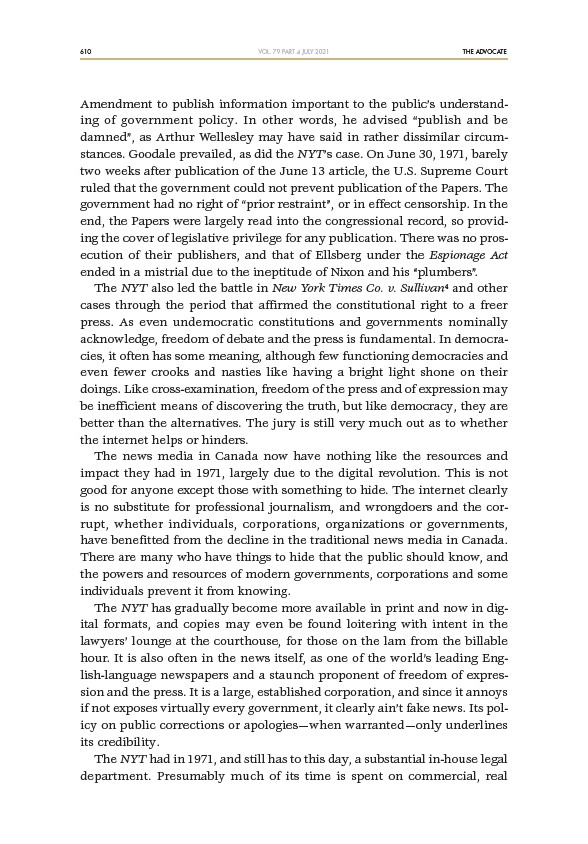
610 THE ADVOCATE
VOL. 79 PART 4 JULY 2021
Amendment to publish information important to the public’s understanding
of government policy. In other words, he advised “publish and be
damned”, as Arthur Wellesley may have said in rather dissimilar circumstances.
Goodale prevailed, as did the NYT’s case. On June 30, 1971, barely
two weeks after publication of the June 13 article, the U.S. Supreme Court
ruled that the government could not prevent publication of the Papers. The
government had no right of “prior restraint”, or in effect censorship. In the
end, the Papers were largely read into the congressional record, so providing
the cover of legislative privilege for any publication. There was no prosecution
of their publishers, and that of Ellsberg under the Espionage Act
ended in a mistrial due to the ineptitude of Nixon and his “plumbers”.
The NYT also led the battle in New York Times Co. v. Sullivan4 and other
cases through the period that affirmed the constitutional right to a freer
press. As even undemocratic constitutions and governments nominally
acknowledge, freedom of debate and the press is fundamental. In democracies,
it often has some meaning, although few functioning democracies and
even fewer crooks and nasties like having a bright light shone on their
doings. Like cross-examination, freedom of the press and of expression may
be inefficient means of discovering the truth, but like democracy, they are
better than the alternatives. The jury is still very much out as to whether
the internet helps or hinders.
The news media in Canada now have nothing like the resources and
impact they had in 1971, largely due to the digital revolution. This is not
good for anyone except those with something to hide. The internet clearly
is no substitute for professional journalism, and wrongdoers and the corrupt,
whether individuals, corporations, organizations or governments,
have benefitted from the decline in the traditional news media in Canada.
There are many who have things to hide that the public should know, and
the powers and resources of modern governments, corporations and some
individuals prevent it from knowing.
The NYT has gradually become more available in print and now in digital
formats, and copies may even be found loitering with intent in the
lawyers’ lounge at the courthouse, for those on the lam from the billable
hour. It is also often in the news itself, as one of the world’s leading English
language newspapers and a staunch proponent of freedom of expression
and the press. It is a large, established corporation, and since it annoys
if not exposes virtually every government, it clearly ain’t fake news. Its policy
on public corrections or apologies—when warranted—only underlines
its credibility.
The NYT had in 1971, and still has to this day, a substantial in-house legal
department. Presumably much of its time is spent on commercial, real